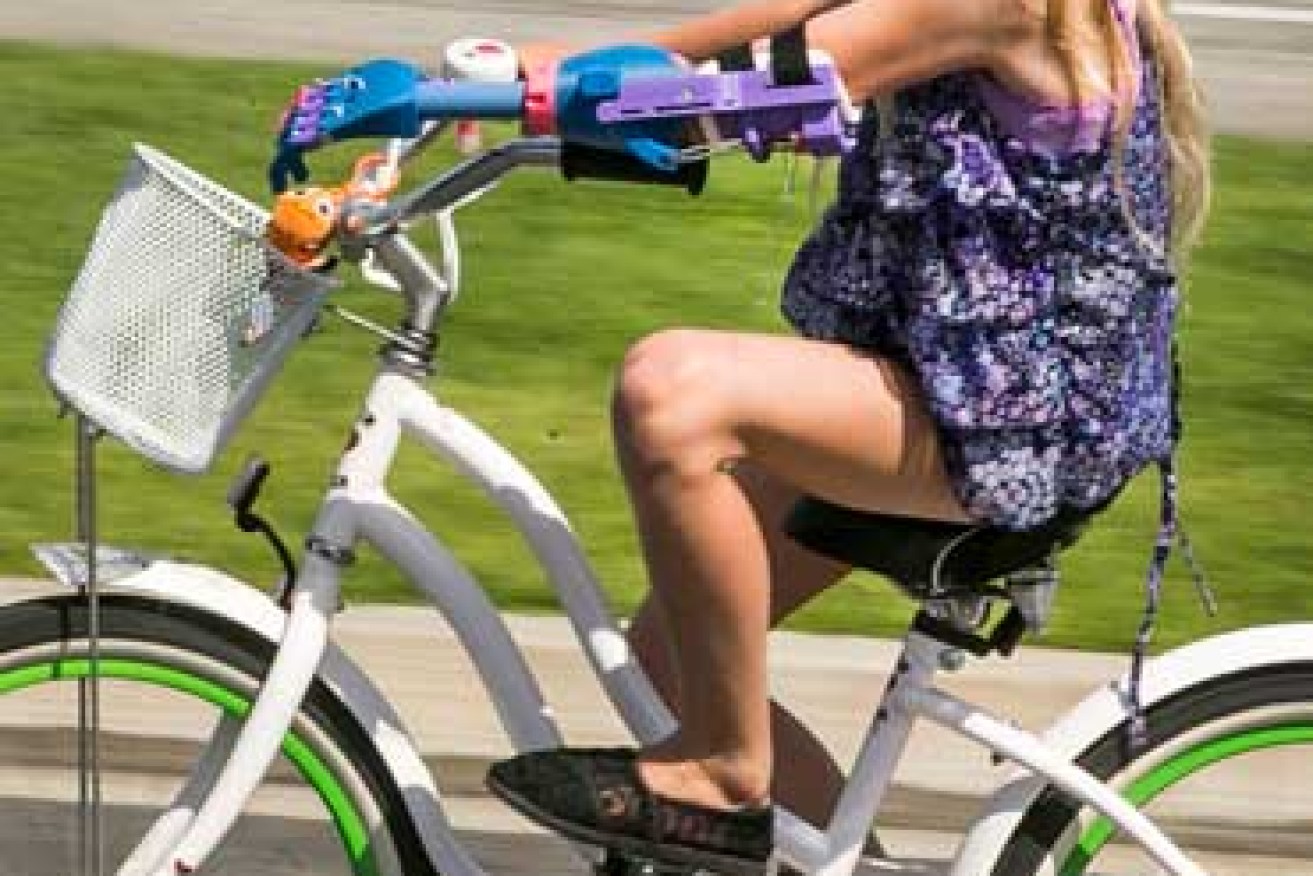How amputees are getting new limbs for $50

The new arm is helping Faith lead a more active life. Photo: AAP
Faith Lennox lost her left hand due to complications during birth, but this never stopped the now seven-year-old from teaching herself to do things such as swim and surf with her father.
She likely could have gone through life doing just fine with one arm.
But now Build It Workspace, a learning centre that offers affordable access to advanced computing equipment such as 3-D printers, has given Faith something she had learned to live without: a complete left arm.
• Three ways your mobile phone is bad for you
• Telstra slammed for sluggish Netflix speeds
• Red Symons’ ode to good old Internet Explorer
Faith was able to design and 3-D print a prosthetic hand with the company, customised with all her favourite colours.
The “robohand” represents a breakthrough for children’s prosthesis. The hand was created in less than a day, is easy to use, and cost a total of $50 to create. Weighing only a pound (around 450 grams), the tool is made of the same materials used in drones and automobile parts.
Faith’s new arm demonstrates a viable solution for children looking for prosthetics. She will need to be refitted with a new hand every six to 12 months as she grows, but instead of her parents spending thousands of dollars for each new model, the total cost will continue to be around $50.
The modernisation of commercial 3-D printers has opened doors for prosthesis. Most prosthetic limbs are made of two components. One part is the replacement limb and the other is the “socket,” which connects the prosthetic to the body. Each part is made with a combination of materials including metals, plastics, and sometimes electronics.
Thanks to modern technology – and a number of charitable organisations and individuals – Faith’s story is becoming more commonplace. From Iron Man presenting a prosthetic limb to a young fan to Boy Scouts building and shipping robotic hands to individuals around the world, amputees everywhere are gaining access to prosthetics in ways they could only have dreamed of years ago. (Even handicapped dogs have benefited from the technology.)
There are still challenges for the technology, including government approvals, funding, and difficulty printing multiple materials at one time, but it has not stopped driven individuals from using 3-D printers to help their fellow man.
While Build It Workspace ended up creating Faith’s hand, her parents originally turned to another notable organisation whose focus is helping amputees: E-Nable.
The nonprofit is a “global community collaborating to make free 3-D-printed prosthetic hands available to all who need them.”
E-Nable’s current staff of about 4,000 volunteers is made up of engineers, occupational therapists, prosthetists, garage tinkerers, designers, philanthropists, and many others who have all come together for the common cause of making prosthesis affordable and accessible.

The new arm is helping Faith lead a more active life. Photo: AAP
Offering everything from design resources to connecting people with owners of 3-D printers, the organisation has so far been able to build 1,000 hands that have gone to help 700 people.
Companies with a focus on poverty-stricken countries have more interesting challenges to deal with. One of these organisations is Not Impossible, which grew out of the award-winning “Project Daniel.” Daniel survived a bomb blast during the civil war in Sudan, but the attack left the teenage boy without hands.
Not Impossible’s founder, Mick Ebeling, returned home from a trip to Sudan, determined to give back the boy’s ability to use his arms.
Not only did he complete his goal, allowing Daniel to feed himself for the first time in two years, Mr Ebeling went on to teach others in the community how to build and maintain the robotic arms to help the thousands of amputees left in the ruins of the war.
But innovators, such as WIliam Root, who invented a similar project called Exo, have continued to push the technology to meet the demands (and desires) of amputees.
Mr Root created a 3-D printing system for super-lightweight, stylish Exo prosthetic legs.
The jet black design is made from titanium powder or high-strength plastic, which, as Wired put it, “makes the wearer look as if they’re materialising from a video game.”
Root is someone who believes that creating prosthetic limbs is like “essentially designing a person” and the product should be as “unique as its owner”.
“Prosthetic limbs are stigmatised because they are so inhuman; most aftermarket companies that try to address this problem attempt to create a realistic-looking leg, which crosses into the uncanny valley,” Root told Wired.
He added that he believes flesh-coloured prosthetics are an attempt at a mass-market appeal, instead of being the “ultimate wearable” tech.
He hopes in the future his mesh design will be able to come in a variety of colours or patterns to fit an individual’s unique style.
As with many looking to advance 3-D printing, Root has run into fundraising and federal roadblocks, but, he says, that will not deter him. The technology is there; it just needs the proper funding.








